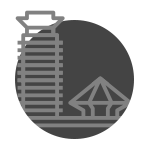A craniotomy is a procedure to excise or resect brain tumours. Specialized tools are used to remove the section of bone called the bone flap. The bone flap is temporarily removed and then the expert neurosurgeons remove the tumours. Once the tumour is removed, the neurosurgeons then replace the removed part of the skull bone.
1. Brain cancers or Brain Tumours
2. Brain Infections
3. Abscesses
4. Cerebral oedema (swelling of the brain)
5. Bleeding within the skull.
6. Blood clots
7. Epilepsy
8. Artervenious malformation (AVM)
9. Parkison’s Disease or dystonia with an internal stimulator device.
1. Endoscopic Craniotomy:
In this procedure, the Neurosurgeons use a surgical tool with a lighted scope and camera at the end of it. It is inserted into the skull through a small incision (cut).
2. Stereotactic Craniotomy:
A radiological scanning process such as CT scan or MRI is used to find the area of the brain needing treatment live during the surgery and in accordance, a surgery is performed.
3. Extended Bi frontal Craniotomy:
An incision (cut) is made behind the hairline to remove the bone that forms the orbital and forehead shape is removed. The tumour is then excised and later the bone is sutured back.
4. Minimally Invasive Supra-Orbital “Eyebrow” Craniotomy:
In this procedure, a small incision is made within the eyebrow to excess tumours in the frontal side of the brain. The benefits include less pain, quick recovery, and minimal scarring.
5. Retro-Sigmoid “Keyhole” Craniotomy:
In this procedure, the surgeon accesses the part of the brain from behind the ears. A small hole is made from behind the ear to access the tumour. This procedure is used to treat brain tumors that are placed on the backside of the brain.
6. Orbitozygomatic Craniotomy:
The procedure is used to access the tumours of optic nerve and the tumors in the areas near teh eyes. During the procedure, the bone between the cheek and the orbit (eye socket) is removed to access the diseased area. This is done to minimize brain damage and allow for better access to the brain.
The cost of craniotomy depends upon the several factors including:
● The clinic that the individual is choosing.
● Medicines
● Regular diagnostic and test processes
● Price of the follows -up care that is necessary after the process.
| Hospital | City | Cost of Investigations | Cost of Procedure |
| W Pratiksha Hospital | Gurugram | USD 800 | USD 6200 |
| Artemis Hospital | Gurugram | USD 800 | USD 6800 |
| Sharda Hospital | Greater Noida | USD 800 | USD 6200 |
| BLK Super Specialty Hospital | New Delhi | USD 800 | USD 7400 |
| Indraprastha Apollo Hospital | New Delhi | USD 800 | USD 7400 |
| Manipal Hospital | New Delhi | USD 800 | USD 7000 |
| Jaypee Hospital | Greater Noida | USD 800 | USD 7400 |
| Medanta Hospital | Gurugram | USD 800 | USD 7400 |
Choosing India to undergo the craniotomy brain tumour surgery will greatly improve the quality of life and cost you lesser than the same quality treatment offered in other parts of the world.
The hospitals in India offering best craniotomy brain tumour surgery are well equipped with the advanced technology and creates miracles in the lives of the international patients. It is suggested to talk with your medical team regarding the procedure, preparation for the surgery and the recovery care following the surgery.
A majority of craniotomy surgeons in India are educated and trained from prestigious foreign institutions that are globally renowned to reproduce some of the best surgeons in the world. Their experience of working abroad helps them to cater the international patients in a more efficient way.
Any patient seeking craniotomy treatment in India, either domestic or international, can approach a renowned hospital in the country to seek consultation from some of the best surgeons available. Patients from abroad may seek free consultation prior to the surgery from the best craniotomy surgeons in India.
There are over 2000 hospitals in India that let patient’s access basic craniotomy treatment. The best neurosurgery hospitals in India keep themselves updated as per the changing technology and techniques used in the field of neurosurgery. The high-end equipment and diagnostic tools installed within these hospitals help keep the success rate of craniotomy treatment in India one of the highest in the world.
Most of the craniotomy treatment hospitals in India have obtained domestic as well as international accreditations from leading quality agencies including Joint Commission International (JCI), National Accreditation Board for Hospitals and Healthcare Providers (NABH) and International Organization for Standardization (ISO). These quality certifications ensure that the hospital constantly maintains its standards with respect to treatment quality and patient satisfaction.
The medical staff at some of the best neurosurgery hospitals in India provide personalized care and attention to each patient coming for treatment. The warmth and affection which international patients get in Indian hospitals make them feel like they are in their home country.
The length of the recovery period and process rely on the type of craniotomy and the reason it was performed. It may take 1 to 4 weeks to recover from this procedure. The doctor will prescribe medicine and rehabilitation therapy depending on your case and requirements.
Brain surgery survival rates depend on the severity of damage to be corrected, the brain surgery type to be performed and the age and health of the patient. On average, brain surgery long-term survival rate can be between 50-70% except in cases of malignant tumours where chances are lowered. In cases of brain operation performed for non-tumour related brain damage, the chances of survival are significantly enhanced.




Dr. Devi Shetty appointment, Dr. Devi Shetty fees, Devi Shetty Hospital Bangalore, Bhavin Desai cardiac surgeon, Best kidney transplant doctor in India
Best hospital for limb lengthening surgery in India, Best hospital for neurosurgery in India, Best hospital for bypass surgery in India, Narayana Hrudayalaya online appointment, Best orthopedic hospital in Bangalore, Best open heart surgery hospital in India, Best bypass surgeon in India, best spine surgery hospital in India, Artemis hospital Gurgaon, KD hospital medical appointment
Limb lengthening surgery cost in India, DSA test, Diabetes treatment in India